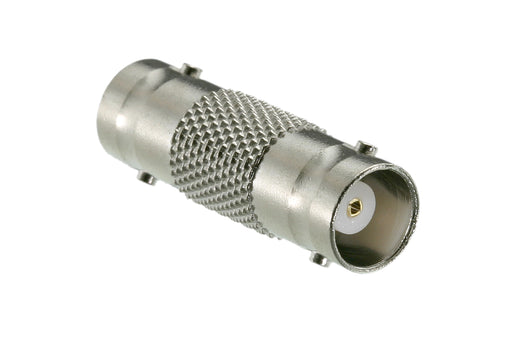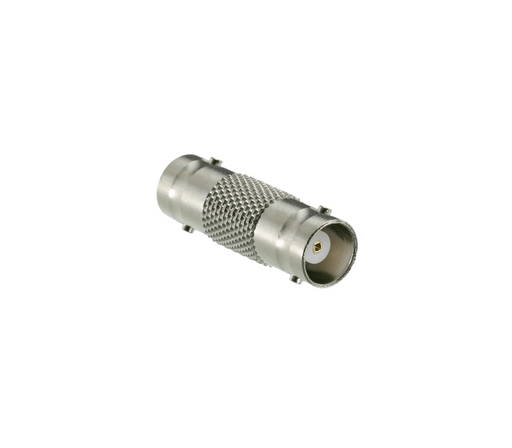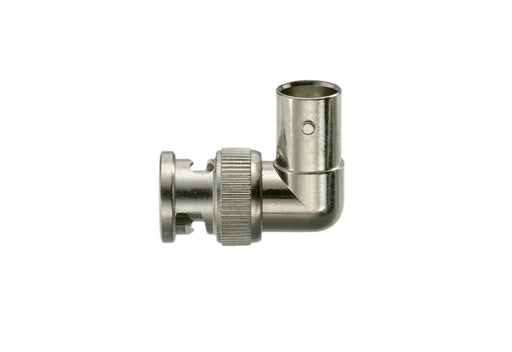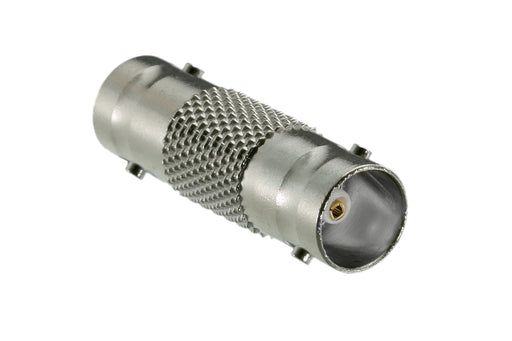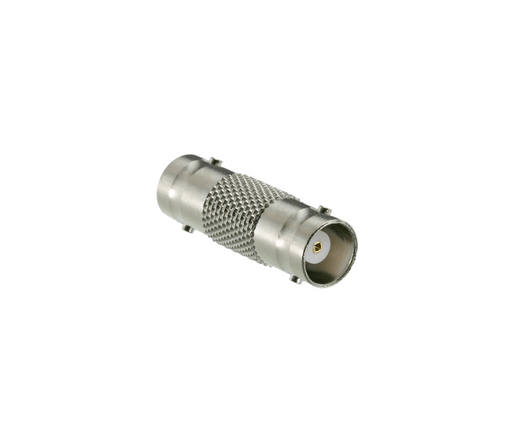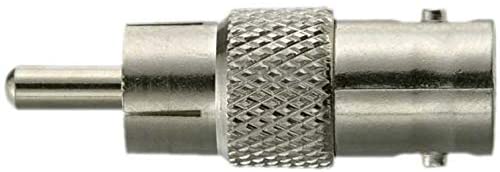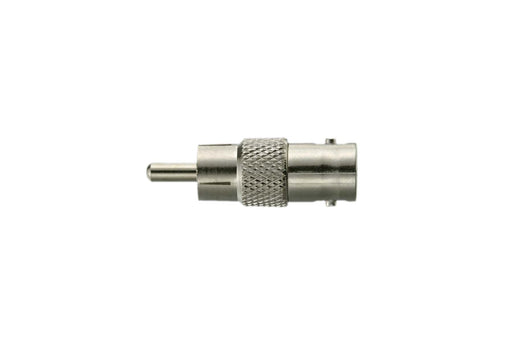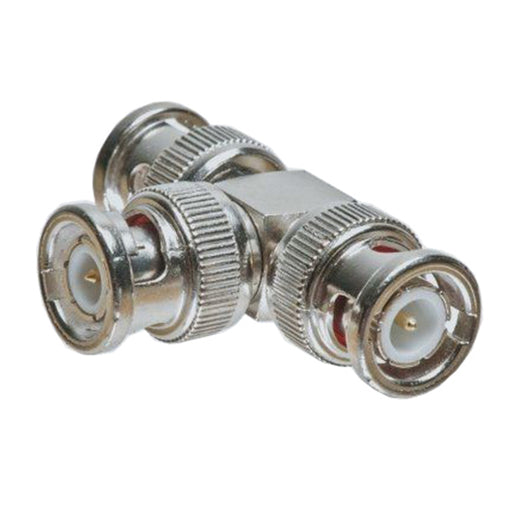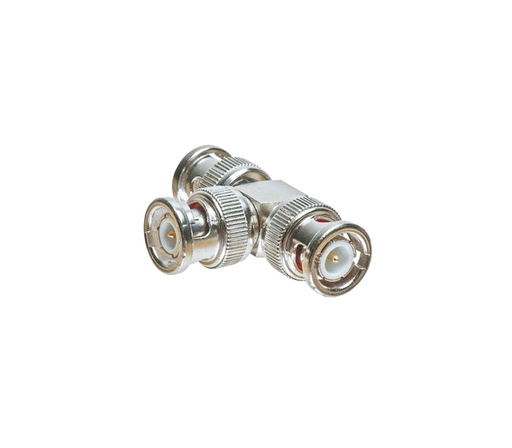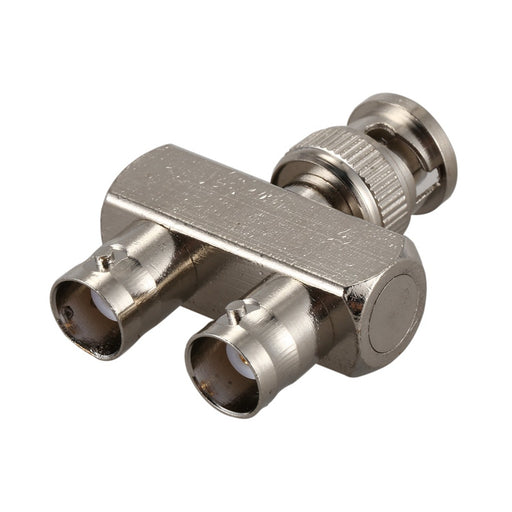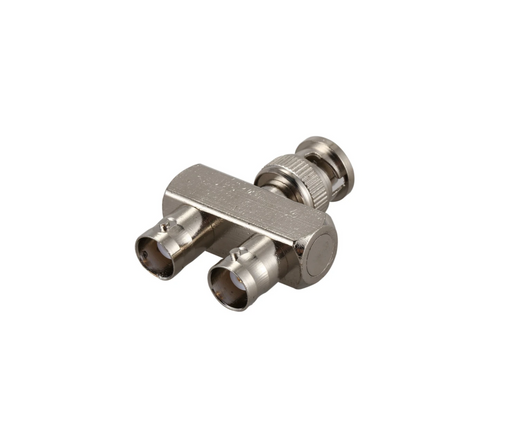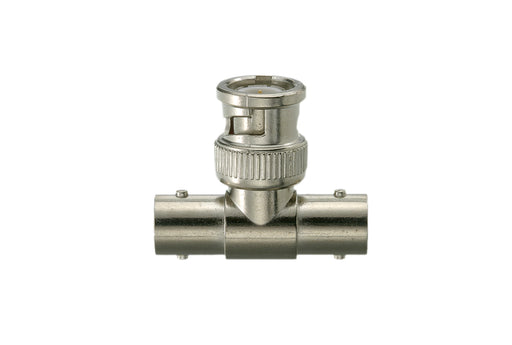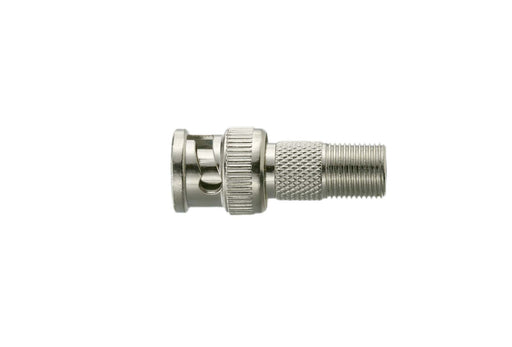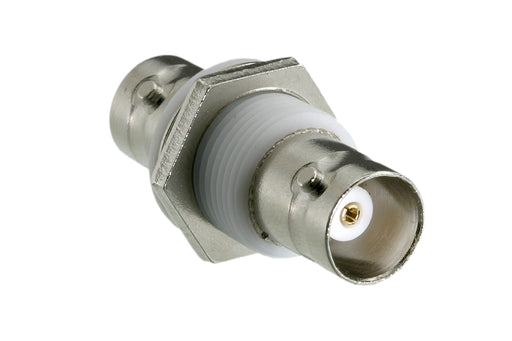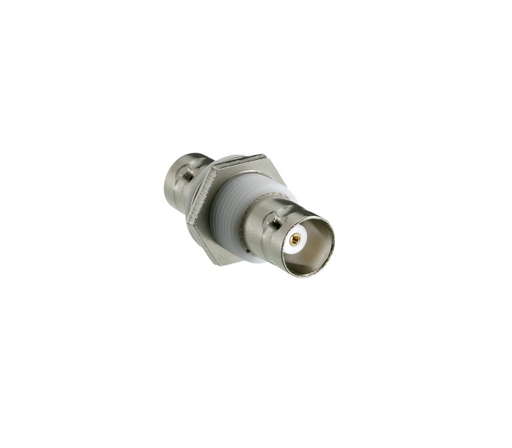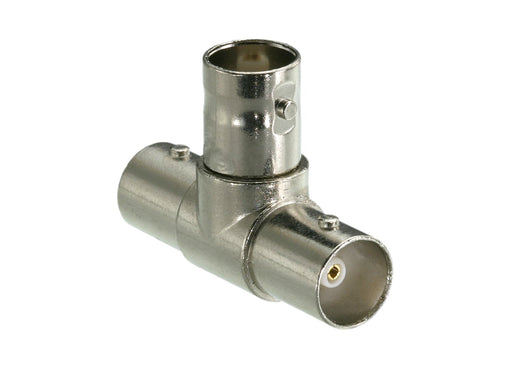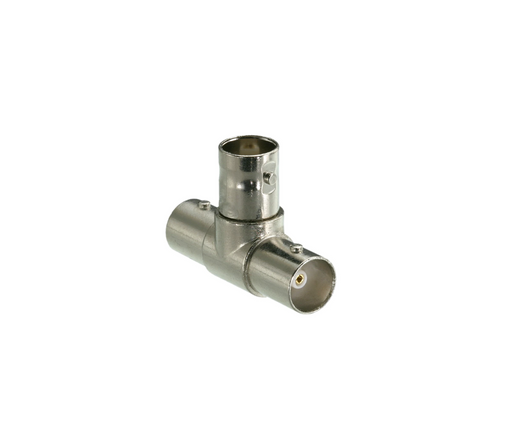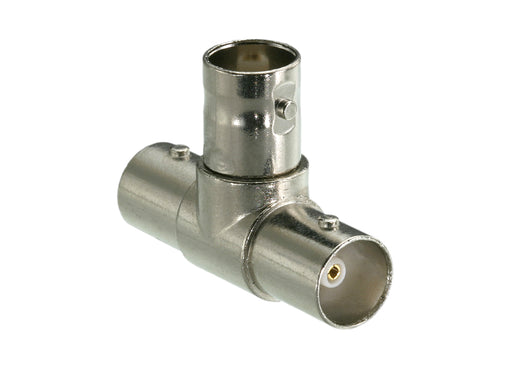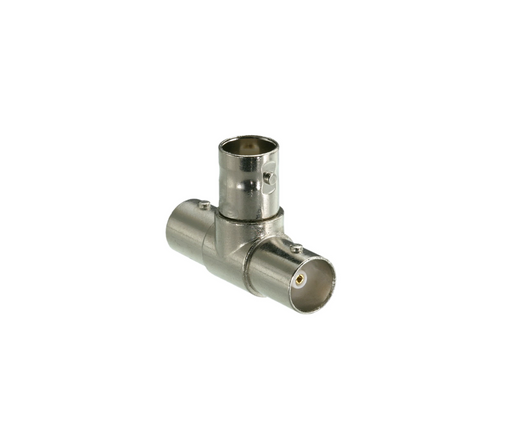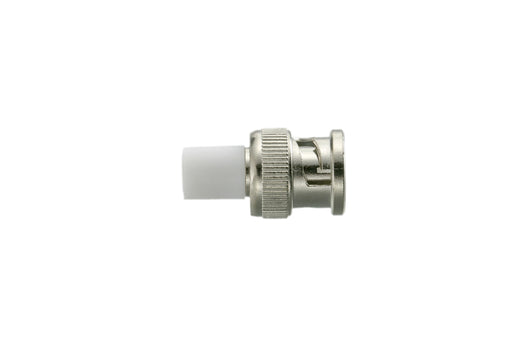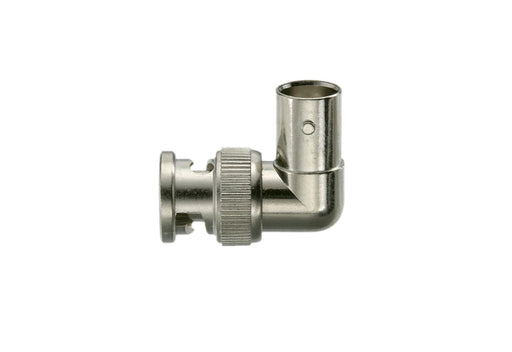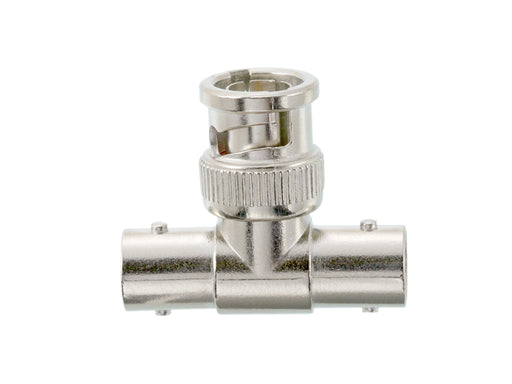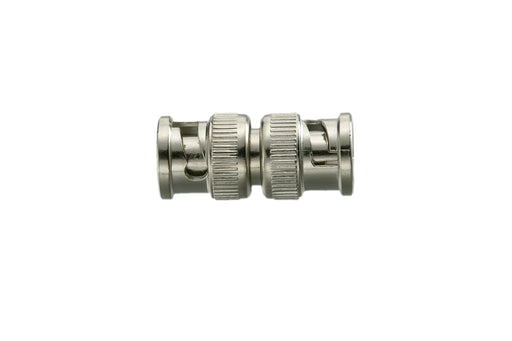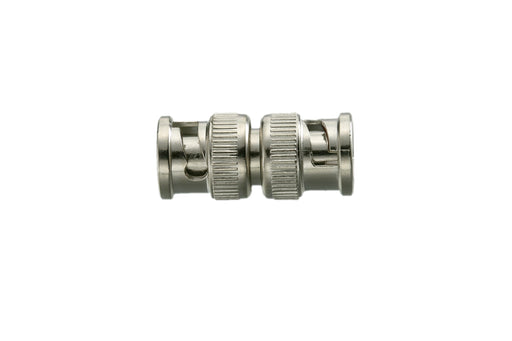
CCTV BNC Adapters
We offer a variety of BNC adapters for sale, most of which are designed to be weatherproof. Hence, they can be used for indoor as well as outdoor applications. On an average, they have an impedance of 50 Ohms or 75 Ohms for most types. They are made of brass, nickel, zinc, and other sturdy metal alloys with a solid finish, which makes them durable, temperature and moisture resistant, and versatile. Some models have a gold plated center contact.
BNC adapters are widely used plug and socket devices to connect various electrical and electronic appliances such as audio and video devices, cameras in network, televisions, surveillance systems, and so on. BNC stands for Bayonet Neill-Concelman, and these small devices offer tight connectivity to the connected coaxial cables.
Filters
Categories
-
Building, Maintenance, and Environmental
- Borescopes & Inspection Cameras
- Laser Distance Meters
- Photo & Contact Tachometers
- Manometers
- CO & CO2 Meters
- F Connectors
- Combustible Gas Detector and Pen
- Humidity Indicators & Meters
- Pin & Pinless Moisture Meters
- Thermometers
- Light Meters
- Sound & Noise Level Meters
- Particle Counter
- Thermo Anemometers
- Hygro-Thermometers
- Hygrometer
- Special Kits
- Refractometer
- Coating Thickness Testers
- PH and Conductivity Meters
-
Electrical Test & Measurement
- Analog Meters -Voltmeters
- Clamp Meter
- Digital Multimeters
- Railroad Test Sets
- Voltage & Current Dataloggers
- Magnetic Field Detectors
- AC Voltage Detector
- Continuity Testers
- Test Leads
- Multimeter Case
- GFCI Receptacle Testers
- Electrical Hand Tools
- Non-Contact Voltage Detection Pens
- Circuit Breaker Tracers
- Special Kits
- Megohmmeters - Insulation Testers
- Power Supplies
- Motor & Phase Rotation Testers
-
Security, CCTV & Cabling Equipment
- Security Camera Testers
- CCTV HD LED Test Monitors
- Baluns, Ground Loop Isolators
- HDMI & IP Extenders
- All Cables
- HDMI Cables
- CAT6a Shielded Cable
- Ethernet Network Cables
- CCTV BNC Adapters
- BNC Connectors
- F Connectors
- BNC Compression Connectors
- CAT5 & CAT6 Connectors
- CCTV Coax Connectors
- Modular Connector
- Between Series Adapters
-
10 PackOriginal price $5.99 - Original price $5.99Original price$5.99$5.99 - $5.99Current price $5.99| /
BNC Adapter, Female/Female, 50 Ohm, 10 Pack - (327-11TP)
GEM by TriplettIn stockBNC Adapter Straight Female/Female, 50 Ohm 10 Pack CATEGORY: BNC ADAPTERS Features Bright nickel finish solid brass or zinc body For use in...
View full detailsOriginal price $5.99 - Original price $5.99Original price$5.99$5.99 - $5.99Current price $5.99| / -
10 PackOriginal price $15.99 - Original price $15.99Original price$15.99$15.99 - $15.99Current price $15.99| /
BNC Adapter, Right Angle Male/Female, 75 Ohm, 10 Pack - (301-RA75-350TP)
GEM by TriplettOut of stock0 Reviews
BNC Adapter Right Angle Male/Female, 75 Ohm 10 Pack CATEGORY: BNC ADAPERS Features Bright nickel finish solid brass or zinc body For use i...
View full detailsOriginal price $15.99 - Original price $15.99Original price$15.99$15.99 - $15.99Current price $15.99| /Out of Stock -
10 PackOriginal price $4.99 - Original price $4.99Original price$4.99$4.99 - $4.99Current price $4.99| /
BNC Adapter, Female/Female, 75 Ohm, 10 Pack - (327-1175TP)
GEM by TriplettIn stockBNC Adapter Straight Female/Female, 75 Ohm High Performance 10 Pack CATEGORY: BNC ADAPTERS Features Bright nickel finish solid brass or zi...
View full detailsOriginal price $4.99 - Original price $4.99Original price$4.99$4.99 - $4.99Current price $4.99| / -
10 PackOriginal price $5.99 - Original price $5.99Original price$5.99$5.99 - $5.99Current price $5.99| /
Between Series Adapter, RCA Phono Male / BNC Female, 10 Pack - (100-350TP)
GEM by TriplettOut of stockBetween Series Adapter - RCA Phono Male / BNC Female. 10 Pack CATEGORY: BETWEEN SERIES ADAPTER Features Bright nickel finish solid brass...
View full detailsOriginal price $5.99 - Original price $5.99Original price$5.99$5.99 - $5.99Current price $5.99| /Out of Stock -
10 PackOriginal price $39.99Original price $39.99 - Original price $39.99Original price $39.99Current price $20.86$20.86 - $20.86Current price $20.86| /
BNC Adapter, "T" Adapter, Male, 10 Pack - (301-T3TP)
GEM by TriplettIn stockBNC "T" Adapter All Male 10 Pack CATEGORY: BNC ADAPTERS Features Bright nickel finish solid brass or zinc body For use in CCTV, HD-TVI, CVI,...
View full detailsOriginal price $39.99Original price $39.99 - Original price $39.99Original price $39.99Current price $20.86$20.86 - $20.86Current price $20.86| /Save 48% Save % -
10 PackOriginal price $34.99 - Original price $34.99Original price$34.99$34.99 - $34.99Current price $34.99| /
BNC Adapter, Female/Male/Female, 50 Ohm, 10 Pack - (301-327750TP)
GEM by TriplettIn stockBNC Adapter Goal Post Female/Male/Female, 50 Ohm 10 Pack CATEGORY: BNC ADAPTERS Features Bright nickel finish solid brass or zinc body For...
View full detailsOriginal price $34.99 - Original price $34.99Original price$34.99$34.99 - $34.99Current price $34.99| / -
10 PackOriginal price $5.40Original price $5.40 - Original price $5.40Original price $5.40Current price $3.64$3.64 - $3.64Current price $3.64| /
BNC Adapter, "T" Female/Male/Female, 50 Ohm, 10 Pack - (301-32750TP)
GEM by TriplettIn stockBNC Adapter "T" Female/Male/Female, 50 Ohm 10 Pack CATEGORY: BNC ADAPTERS Features Bright nickel finish solid brass or zinc body For use i...
View full detailsOriginal price $5.40Original price $5.40 - Original price $5.40Original price $5.40Current price $3.64$3.64 - $3.64Current price $3.64| /Save 33% Save % -
10 PackOriginal price $8.49 - Original price $8.49Original price$8.49$8.49 - $8.49Current price $8.49| /
Between Series Adapter, BNC Male/Female, 10 Pack - (301-0401TP)
GEM by TriplettIn stockBetween Series Adapter - BNC Male / F Female. 10 Pack. CATEGORY: BETWEEN SERIES ADAPTER Features Bright nickel finish solid brass or zinc...
View full detailsOriginal price $8.49 - Original price $8.49Original price$8.49$8.49 - $8.49Current price $8.49| / -
10 PackOriginal price $17.49 - Original price $17.49Original price$17.49$17.49 - $17.49Current price $17.49| /
BNC Adapter, Female/Female 50 Ohm, 10 Pack - (329-0TP)
GEM by TriplettOut of stockBNC Adapter Bulkhead Female/Female, 50 Ohm 10 Pack CATEGORY: BNC ADAPTERS Features Bright nickel finish solid brass or zinc body For use i...
View full detailsOriginal price $17.49 - Original price $17.49Original price$17.49$17.49 - $17.49Current price $17.49| /Out of Stock -
10 PackOriginal price $11.99 - Original price $11.99Original price$11.99$11.99 - $11.99Current price $11.99| /
BNC Adapter, "T" Female/Female/Female, 75 Ohm, 10 Pack - (327-753TP)
GEM by TriplettOut of stockBNC Adapter "T" Female/Female/Female, 75 Ohm High Performance. 10 Pack CATEGORY: BNC ADAPTERS Features Bright nickel finish solid brass or...
View full detailsOriginal price $11.99 - Original price $11.99Original price$11.99$11.99 - $11.99Current price $11.99| /Out of Stock -
10 PackOriginal price $11.99 - Original price $11.99Original price$11.99$11.99 - $11.99Current price $11.99| /
BNC Adapter, "T" Female/Female/Female, 50 Ohm, 10 Pack - (327-3TP)
GEM by TriplettOut of stockBNC Adapter "T" Female/Female/Female, 50 Ohm 10 Pack CATEGORY: BNC ADAPTERS Features Bright nickel finish solid brass or zinc body For use...
View full detailsOriginal price $11.99 - Original price $11.99Original price$11.99$11.99 - $11.99Current price $11.99| /Out of Stock -
10 PackOriginal price $11.99 - Original price $11.99Original price$11.99$11.99 - $11.99Current price $11.99| /
BNC Adapter, Male, 75 Ohm, 10 Pack - (301-T75TP)
GEM by TriplettIn stockBNC Male Termination 75 Ohm, 1/2 Watt 1%, Purple Cap 10 Pack CATEGORY: BNC ADAPTERS Features Bright nickel finish solid brass or zinc body ...
View full detailsOriginal price $11.99 - Original price $11.99Original price$11.99$11.99 - $11.99Current price $11.99| / -
10 PackOriginal price $24.99 - Original price $24.99Original price$24.99$24.99 - $24.99Current price $24.99| /
BNC Adapter, Right Angle Male/Female, 50 Ohm, 10 Pack - (301-RA-350TP)
GEM by TriplettIn stockBNC Adapter Right Angle Male/Female, 50 Ohm 10 Pack CATEGORY: BNC ADAPTERS Features Bright nickel finish solid brass or zinc body For use ...
View full detailsOriginal price $24.99 - Original price $24.99Original price$24.99$24.99 - $24.99Current price $24.99| / -
10 PackOriginal price $6.99 - Original price $6.99Original price$6.99$6.99 - $6.99Current price $6.99| /
BNC Adapter, "T" Female/Male/Female, 75 Ohm, 10 Pack - (301-327T75TP)
GEM by TriplettOut of stockBNC Adapter "T" Female/Male/Female, 75 Ohm High Performance 10 Pack CATEGORY: BNC ADAPTERS Features Bright nickel finish solid brass or zinc...
View full detailsOriginal price $6.99 - Original price $6.99Original price$6.99$6.99 - $6.99Current price $6.99| /Out of Stock -
10 PackOriginal price $9.99 - Original price $9.99Original price$9.99$9.99 - $9.99Current price $9.99| /
BNC Adapter, Male, 50 Ohm, 10 Pack - (301-301TP)
GEM by TriplettLow stockBNC Adapter Straight Male/Male, 50 Ohm 10 Pack CATEGORY: BNC ADAPTERS Features Bright nickel finish solid brass or zinc body For use in CC...
View full detailsOriginal price $9.99 - Original price $9.99Original price$9.99$9.99 - $9.99Current price $9.99| / -
10 PackOriginal price $11.99 - Original price $11.99Original price$11.99$11.99 - $11.99Current price $11.99| /
BNC Adapter, Male, 75 Ohm, 10 Pack - (301-301-75TP)
GEM by TriplettOut of stockBNC Adapter Straight Male/Male, 75 Ohm 10 Pack CATEGORY: BNC ADAPTERS Features Bright nickel finish solid brass or zinc body For use in C...
View full detailsOriginal price $11.99 - Original price $11.99Original price$11.99$11.99 - $11.99Current price $11.99| /Out of Stock
Know More About Triplett BNC Adapter
What is BNC Adapter
A BNC (Bayonet Neill-Concelman) adapter is a type of connector used in electronic and electrical applications to join or adapt cables and devices with BNC connectors. BNC connectors are commonly used for transmitting radio frequency (RF) signals, analog and digital video signals, and other high-frequency signals.
What is BNC T Adapter?
A BNC T-adapter, also known as a BNC tee or BNC splitter, is a specialized connector used in electronic and electrical applications to split one BNC signal into two separate signals or combine two BNC signals into one. It is named for its T-shaped configuration, which resembles the letter "T."
Types of BNC Adapters
BNC (Bayonet Neill-Concelman) adapters come in various configurations to suit different connectivity needs in electronic and electrical applications. Here are some common types of BNC adapters:
-
BNC Male to BNC Male Adapter:
- This adapter has two male BNC connectors on either end.
- It is used to connect two cables or devices with female BNC connectors together.
- Commonly used for extending the length of a cable or connecting two BNC cables.
-
BNC Female to BNC Female Adapter:
- This adapter has two female BNC connectors on either end.
- It is used to connect two cables or devices with male BNC connectors together.
- Often used to join two cables with male connectors.
-
BNC Male to BNC Female Adapter:
- This adapter has a male BNC connector on one end and a female BNC connector on the other.
- It allows you to connect a cable or device with a male BNC connector to one with a female BNC connector.
- Useful for adapting cables with different connector genders.
-
BNC T-Adapter:
- A BNC T-adapter, also known as a BNC tee or BNC splitter, has one female BNC connector and two male BNC connectors.
- It is used for splitting one BNC signal into two separate signals or combining two BNC signals into one.
- Commonly used in applications where signal distribution or merging is required.
-
BNC Bulkhead Adapter:
- This adapter is designed to be mounted on a panel, enclosure, or bulkhead.
- It typically has a female BNC connector on both ends, allowing for connections on both sides of the panel.
- Used in situations where BNC connections need to pass through a barrier or enclosure.
-
BNC to RCA Adapter:
- This adapter has a male BNC connector on one end and a female RCA (phono) connector on the other.
- It enables the connection between BNC and RCA equipment, such as connecting BNC surveillance cameras to RCA monitors.
-
BNC to SMA Adapter:
- This adapter allows you to connect a device with a BNC connector to one with an SMA (SubMiniature version A) connector.
- Commonly used in RF and antenna applications.
-
BNC to N-Type Adapter:
- This adapter enables the connection between a device with a BNC connector and one with an N-type connector.
- Often used in RF and wireless communications.
-
BNC Right-Angle Adapter:
- This adapter has a male BNC connector on one end and a female BNC connector at a right angle on the other.
- It is useful when space constraints or cable routing require a right-angle connection.
-
BNC Terminator:
- While not an adapter in the traditional sense, a BNC terminator is used to terminate an open BNC connector to prevent signal reflection in coaxial systems.
These are just a few examples of the many BNC adapters available, each designed for specific connectivity needs. The choice of adapter depends on the requirements of your particular application and the types of equipment and cables you are using.
How is a BNC T Adapter used in a network?
A BNC T-adapter, also known as a BNC tee or BNC splitter, can be used in a network for various purposes, depending on the specific network configuration and requirements. Here are some common use cases for a BNC T-adapter in networking:
- Signal Distribution: In older Ethernet networks and some specialized applications, BNC connectors were used for network connections. A BNC T-adapter can be used to split a single network connection into two or more branches. For example, it can be used to connect multiple computers or devices to the same network segment.
- Network Testing: BNC connectors are often used in network testing and diagnostics. A BNC T-adapter can be employed to split the network signal, allowing network technicians to monitor or analyze network traffic without disrupting the main network connection. This is particularly useful for troubleshooting and monitoring purposes.
- Connection Redundancy: In some critical applications, redundancy is essential to ensure network reliability. BNC T-adapters can be used to create redundant network connections. If one network path fails, the redundant path can take over, minimizing downtime.
- Network Segmentation: BNC T-adapters can be used to segment a network into different parts or segments. Each segment can have its own set of devices and connections. This is commonly done for security or organizational reasons.
- Legacy Network Equipment: In environments with legacy network equipment that uses BNC connectors, a BNC T-adapter may be used to integrate older equipment into a modern network setup. It allows the connection of legacy devices to the network without the need for costly equipment upgrades.
- Temporary Connections: BNC T-adapters are sometimes used for temporary network connections. For instance, in a situation where a temporary workstation needs to be connected to the network, a BNC T-adapter can be used to tap into an existing network cable without the need for permanent modifications.
It's important to note that BNC connectors and BNC T-adapters are less common in modern Ethernet networks, where RJ45 connectors have become the standard. However, they may still be found in older or specialized network installations
When using BNC T-adapters in a network, it's crucial to ensure that the network topology and connections are properly configured to meet the specific needs of the network and to avoid signal loss or interference. Additionally, consider the impedance requirements of your network, as BNC connectors and cables come in both 50-ohm and 75-ohm versions, and impedance matching is important for signal integrity.
How do you use a BNC adapter?
A BNC adapter is quite easy to use with tight fitting capabilities, and can be easily installed on a coax cable. You need to cut off the insulating portion of the coaxial cable up to an inch or so. Once the metal wire part is exposed, check its diameter and ensure it is a bit less than that of the adapter, such that the pole of the adapter can cover the exposed wire strands. Some portions of the wire strands must be spread out such they remain at the outside end of the T adapter. Cover the wires with the tube that fits onto the wire strands and fix it well from the top so that it remains tight. This way one end of the T-shaped adapter gets connected to a coaxial cable.
What are CCTV BNC Adapter used for?
CCTV BNC adapters are used in closed-circuit television (CCTV) systems to facilitate connections between various components of the surveillance system. These adapters help ensure compatibility and flexibility in setting up CCTV cameras and related equipment. Here are common uses for CCTV BNC adapters:
- Camera Connections: CCTV cameras typically have BNC connectors for video output. BNC adapters are used to connect these cameras to other devices, such as monitors, recorders, or video switchers, which may have different types of connectors (e.g., RCA, VGA, HDMI).
- Extension Cables: In CCTV installations where camera placement requires longer cable runs, BNC adapters can be used to extend the reach of BNC cables. This is especially useful when cameras need to be positioned at a distance from the recording or monitoring equipment.
- Signal Conversion: CCTV BNC adapters can convert video signals from BNC to other formats, such as RCA or VGA. This allows you to connect CCTV cameras to older monitors or equipment that use different connectors.
- Connector Gender Conversion: BNC connectors come in male and female versions. CCTV BNC adapters can change the gender of the connector to ensure compatibility between cables and devices with different genders.
- Signal Splitting: BNC T-adapters or splitters can be used to split a single CCTV camera signal into multiple branches. This is useful for routing the same video feed to multiple monitors or recorders simultaneously.
- Signal Testing: During CCTV system installation or maintenance, BNC adapters may be used for signal testing and diagnostics. They enable technicians to connect testing equipment, such as oscilloscopes or signal analyzers, to assess the quality of the video signal.
- Integration with Other Systems: In some cases, CCTV systems may need to integrate with other systems, such as access control or alarm systems, which use different connectors. BNC adapters facilitate these integrations by ensuring a seamless connection.
- Camera Replacement: When upgrading or replacing CCTV cameras, BNC adapters can be valuable in cases where the new camera has a different type of video output connector than the old one. This allows you to connect the new camera to the existing wiring infrastructure.
- Temporary Connections: CCTV BNC adapters are useful for creating temporary connections for testing or special events. They allow for quick and flexible setup without permanent modifications.
Overall, CCTV BNC adapters play a crucial role in ensuring that different components within a surveillance system can work together harmoniously, providing reliable video monitoring and recording capabilities.
What is the difference between 50 Ohm and 75 ohm BNC Adapter?
Typically, 75 Ohms adapters are used for HD videos and audio formats, while 50 Ohms are suited for basic analog devices. This is the impedance measured in Ohms which is also matched with that of cables. However, 50 Ohms has excellent power handling profile and low signal attenuation as the signals are transmitted over the cable carrying AC current. Adapters with 75 Ohms impedance also have low signal attenuation but a far lesser capacitance then the former, which helps prevent signal distortion.
Browse More Security, CCTV & Cabling Equipment Collections
Camera Install & Maintenance:
| Security Camera Testers | HDMI Cables | CAT6a Shielded Cable |
| HD LED Test Monitors | Baluns, Converters & Hubs | HDMI & IP Extenders |
CCTV Connectors:
| Compression Connectors | RJ45 (CAT5-6)Connectors | Cabling Hand Tools & Kits |
| CCTV Coax Connectors | Modular Connector | Between Series |
| BNC Connectors | F Type Connectors |

